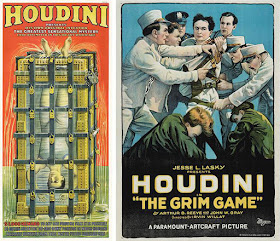In
Houdini & Doyle episode 8, "Strigoi,"
Dracula author Bram Stoker is at the center of vampiric mystery and horror story. But it's the ending that will give Houdini fans with the biggest shock. First, the mystery...
Vampires! Or rather, Vanatoarea, those who hunt vampires, are now hunting those who glorify vampires, and there's no greater offender than Bram Stoker (Paul Ritter). Stoker seeks the help of his good friend, Arthur Conan Doyle, when the murder of his maid raises the stakes (wooden and otherwise).
The current situation is stirred up by the "paperback" publication of
Dracula. Houdini takes delight in tweaking Doyle, the creator of Sherlock Holmes, by proclaiming Dracula as "the most famous character in all of fiction." Houdini even invites Stoker to stay in his hotel suite. But Stoker starts showing signs that he might be a vampire himself; his nocturnal sojourns witnessed by Houdini's own mother.
This action this time takes place in an assortment of Gothic settings, including a graveyard in which Houdini finds himself buried alive. This is a highlight of the episode, but it also shows up what I believe is the series greatest flaw.
Houdini doesn't escape.
In my opinion, part of the appeal and promise of this entire series concept is that we have in Houdini a "detective" who has the ability to free himself from all forms of restraint. This is built into the idea, just as it is built into Houdini's own silent movies. While this was somewhat exploited in early episodes (mainly with lock picking), in the second half of the series, Houdini's skills as both a magician and escape artist have been largely absent. The series has turned Houdini into a detective with no special abilities other than cocksureness.
But now we have an opportunity for a showcase Houdini escape [see below]. Instead, they opt to have Houdini rescued by Doyle and Adelaide. If the writer couldn't figure out a way to have Houdini escape (there are methods), then he could have had him mysteriously free by the time Doyle and Adelaide arrive. He's Houdini. He did that! Also recall that in real life Doyle came to believe Houdini himself possessed supernatural powers that he concealed. This would have been a perfect way to begin to build that belief in Doyle's mind. A missed opportunity.
In the end, Stoker's mysterious vampiric predilections turn out to be the advanced stages of Syphilis. But it's the very end of the episode that provides the biggest shock when Houdini returns to his hotel suite to find his mother has passed away in her sleep. And that brings us to...
Just the Facts
Before we get into mama's death, lets tackle some of the other Houdini history in this episode. The episode shows Houdini as a gushing fan of
Dracula and Stoker's work. While it's likely the real Houdini read
Dracula, we unfortunately don't have anything that records his thoughts on the famous vampire. All we have of Houdini and Dracula is a fictional meeting in the 1991 comic
The Ghosts of Dracula. As far as Houdini not being able to whistle...that's one I've never heard.

As discussed, Houdini finds himself buried alive in this episode. The idea of a buried alive escape fascinated Houdini and was something he worked on throughout his career. In 1914 he conceived of a stage-bound version that had him buried in a casket under "tons of sand." While a poster was created for the new feat (right), it's unclear if he ever performed it at this time.
Houdini attempted an outdoor buried alive escape in Santa Ana, California, in which he was buried without cover in a grave six feet deep. Much to his horror, Houdini discovered the "weight of the earth is crushing" and called for help. But he couldn't be heard. He had to claw his way to the surface where he passed out. It was a his closest brush was death.
[Interestingly, when I
met Michael Weston at the Magic Castle, he told me about shooting the buried alive sequence and, without realizing it, used Houdini's exact phrasing about the weight of the earth being crushing.]
Finally, in September 1926, Houdini perfected his stage-bound Buried Alive and performed it in Boston and Worcester. It would have become a regular feature of his
full evening show, but he died the following month. His body was shipped back to New York in the casket he created for this escape.
The death of Houdini's mother was a seminal moment in his life. "He was never the same man after his mother's death," wrote one acquaintance.
Houdini & Doyle is set in 1901. Cecelia Weiss died in 1913. But it is correct that she died in a hotel while on the road. Except the son she was traveling with was Houdini's brother, Theo Hardeen, who was also an escape artist. Hardeen brought Mama with him to Asbury Park, New Jersey, where she suffered a stroke upon their arrival and died 3 days later in Room 18 of the Imperial Hotel. Houdini, who was performing in Copenhagen, fainted when he received the telegram from Hardeen informing him of her death.
Finally, there is a nice line when Houdini and Doyle are debating the possibility of vampires. Doyle suggests immortality might be tied to evolution. Houdini dismisses this by saying, "The only path of immortality is fame. People will be talking about me for hundreds of years."
Fact!
Next Monday:
Houdini & Doyle meet Thomas Edison in "Necromanteion."
Related:


















































